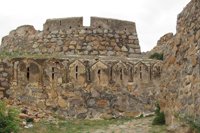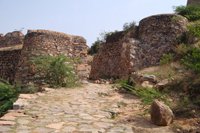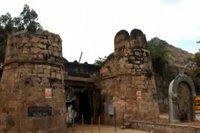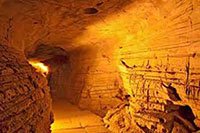
 Prashanthi Nilayam ashram was the residence of the notable spiritual teacher Sathya Saibaba of Puttaparthi in India.
The main attraction of the Puttaparthi town is Baba and his Prashanthi Nilayam ashram. It has enhanced the local economy, in the form of hotels, lodges, restaurants and shops which are largely required by the visitors to the ashram. The language is not a problem here for anyone because many languages are spoken in Puttaparthi, particularly Telugu, Tamil, Kannada, Hindi and English. The climate is generally hot and dry throughout the year. During summer temperature may range from 34 °C-42 °C, (93F-108F) and in winter 22 °C-27 °C (71F-80F). Puttaparthi is 475 meters (1558 feet) above sea level.
Prashanthi Nilayam ashram was the residence of the notable spiritual teacher Sathya Saibaba of Puttaparthi in India.
The main attraction of the Puttaparthi town is Baba and his Prashanthi Nilayam ashram. It has enhanced the local economy, in the form of hotels, lodges, restaurants and shops which are largely required by the visitors to the ashram. The language is not a problem here for anyone because many languages are spoken in Puttaparthi, particularly Telugu, Tamil, Kannada, Hindi and English. The climate is generally hot and dry throughout the year. During summer temperature may range from 34 °C-42 °C, (93F-108F) and in winter 22 °C-27 °C (71F-80F). Puttaparthi is 475 meters (1558 feet) above sea level.
Puttaparthi is well connected by road to all parts of Anantapur district which is at 84 kms. Hyderabad is at about 440 kms and Bangalore is at about 154 kms to Puttaparthy. The state transport buses ply to this place from every south Indian state regularly apart from hundreds of tourist vehicle from various parts of the country. There is a railway station named after Sri Sathya Sai Prashanthi Nilayam which is about 8 kms from the ashram, coming within the Bangalore Division of the South Western Railway on Bangalore-Guntakal line. The airport is 6 kms (3.7 mi) away from the ashram, owned by the Sri Sathya Sai Central Trust. The other nearest airport is the Airport at Devanahalli in Bangalore at about 119 kms from Puttaparthi.
Sathya Sai Baba established this ashram in 1950 for bringing together his followers who have swollen to gigantic figures. Prashanthi Nilayam (Abode of sacred peace) is a large complex with guesthouses, dormitories Kitchens and dining halls. In addition there are several buildings around the ashram like schools, colleges, residential complexes, hospitals, Planetarium, museum and recreation centre. These developments by Baba have transformed the small rural community into Metropolitan city complex. Nevertheless at the lower end of the village, rural life continues, seemingly unaffected by the ashram's activities.
When you are on South Indian tour make it a point to visit Sathya Sai ashram of Puttaparthi. There are many other interesting places to see. They are Lord Satyabhama temple, Lord Shiva temple, Chitravati river, "Kalpavruksha" (tree that gives desired fruit) namely tamarind tree from which Baba miraculously produced exotic fruits and most important the Sathya Sai super specialty hospital.
Sathya Sai’s devotees are spread over throughout this planet. It is estimated that over 80 million and spread over in 100 countries in this sphere. His devotees believe that he is not merely a mystic but an incarnation of God himself.
 Iskon temple at Somuladoddi near Ananthapur - on the Bangalore- Hyderabad National Highway. The temple is located around 200 Kms from Bangalore and around 5 to 6 kms beyond Ananthapur.It is much much smaller (& simpler) than the one in Bangalore. However the temple is constructed artistically in the shape of a Chariot with four wheels pulled by four horses.
Iskon temple at Somuladoddi near Ananthapur - on the Bangalore- Hyderabad National Highway. The temple is located around 200 Kms from Bangalore and around 5 to 6 kms beyond Ananthapur.It is much much smaller (& simpler) than the one in Bangalore. However the temple is constructed artistically in the shape of a Chariot with four wheels pulled by four horses.
 This magnificent fort is situated on the foothills of the Rayadurg Town. This unique hill fort was constructed by Junga Nayak. A part of this fort wall has disintegrated. There are four caves placed beneath the slope which has small doors of stone with sculptors of Siddhas. The area of the fort comprises of many village temples like Elamma, Narashimhaswamy and Hanuman.
This magnificent fort is situated on the foothills of the Rayadurg Town. This unique hill fort was constructed by Junga Nayak. A part of this fort wall has disintegrated. There are four caves placed beneath the slope which has small doors of stone with sculptors of Siddhas. The area of the fort comprises of many village temples like Elamma, Narashimhaswamy and Hanuman.
 The Gooty fort is around 50 Kms from Anantapur, situated at a height of 300 meters above the sea level in Gooty. The fort was built during the Chalukyan times. Major part of this fort was fortified and strengthened during the Vijayanagara era.
The Gooty fort is around 50 Kms from Anantapur, situated at a height of 300 meters above the sea level in Gooty. The fort was built during the Chalukyan times. Major part of this fort was fortified and strengthened during the Vijayanagara era.
The Fort has been granted the title of ’World Heritage Site’ by UNESCO. The exact construction date of the fort is not known, according to the historical records the earliest inscriptions found in the structure date back to the 7th century. The fort was captured by Mir Jumla and then came under the sway of Qutub Shahi chiefs. In 1773, it was captured by Haider Ali & Tippu Sultan and later fell into the British hands. About 10 Km away from Gooty Fort, archeologists have discovered a stone on which constitution belonging to Ashoka is written.
The Fort was build primarily from Security point of view. No structure inside the fort has any architectural magnitude & has not withstood the ravages of times. The fort is built in the shape of a shell and has 15 inner forts with 15 main doors in an area of approximately 25 acres. The fort of Gooty is an amalgamation of Hindu-Islamic architecture. The fort has numerous temples, including Nageswara Swamy Temple, Lakshminarasimhaswamy Temple and Ramaswamy Temple.
On the top of the fort a small pavilion made in polished lime stone is known as Morari Rao’s seat. It offers a panoramic view of the town below and is believed to be the favorite resort of Maratha ruler Morari Rao. Sitting on the top of the fort & watching the sunset, beautiful landscape & a walk in the evening is probably the best activity to do. It takes approximately thirty minutes to climb the fort but for photography enthusiast it may take little more time to climb the fort as there’s lots of stuff to be photographed.
Gooty Fort is one of the must visit attractions of Anantapur, Visit this place to see its beauty which it offers through its forts & temples. In fact this is the only place where one can see the panoramic view of nearby villages. People visiting Gooty Fort near Anantapur for study tour, picnic or a social event, they will surely discover the unusual blend of culture and natural beauty that makes Gooty so special.
 Penukonda Fort is one of the must visit attractions of near Anantapur, Visit this place to see its beauty which it offers through its forts & temples. This place is around 65 Kms from Anantapur. It served as the capital of the Vijayanagara Empire for a short period. This is one of the holiest places in south India, It has 365 temples of Lord Hanuman. This place is also popular for the Babaiah Dargah (Mausoleum) The Dargah of 12th Century Sufi Saint Hazrat Syed Shah Baba Fakruddin Suharwardy
Penukonda Fort is one of the must visit attractions of near Anantapur, Visit this place to see its beauty which it offers through its forts & temples. This place is around 65 Kms from Anantapur. It served as the capital of the Vijayanagara Empire for a short period. This is one of the holiest places in south India, It has 365 temples of Lord Hanuman. This place is also popular for the Babaiah Dargah (Mausoleum) The Dargah of 12th Century Sufi Saint Hazrat Syed Shah Baba Fakruddin Suharwardy
 The Sri Sathya Sai Hill View Stadium is located behind the Sri Sathya Sai Higher Secondary School in the Vidya Giri area. Shanthi Vedika is the ornate structure where Baba sits to view the events that take place in the stadium. On top of one the series of hills that overlook the sprawling ground, is the sixty-five foot statue of Hanuman. There are also statues of Buddha, Shiva, Krishna, Christ and Zarthushtra almost in a line below Hanuman. The entire hill wears a beautiful bucolic look with greenery. I remember about twenty years ago the hills were dry and rocky. Below the foot of the hills are tiers of seating for the spectators..
The Sri Sathya Sai Hill View Stadium is located behind the Sri Sathya Sai Higher Secondary School in the Vidya Giri area. Shanthi Vedika is the ornate structure where Baba sits to view the events that take place in the stadium. On top of one the series of hills that overlook the sprawling ground, is the sixty-five foot statue of Hanuman. There are also statues of Buddha, Shiva, Krishna, Christ and Zarthushtra almost in a line below Hanuman. The entire hill wears a beautiful bucolic look with greenery. I remember about twenty years ago the hills were dry and rocky. Below the foot of the hills are tiers of seating for the spectators..
The Sports and Cultural Festival for Sri Sathya Sai School and colleges is held here on 11th January every year.
A special cricket pitch of international standard was constructed in 1997. The Sri Sathya Sai Unity Cup was played there on 30th December 1997 in which famous cricketers from all over the world participated.
 The mortal remains of Sathya Sai Baba’s parents, Sri Pedda Venkama Raju and Smt. Eswaramma, are housed in a mausoleum (Samadhi) off the Main road, down the ‘Samadhi Road.’ The Samadhi is made of black stone, and always kept spotlessly clean. There is also a Ganesha idol in front of the Samadhi. Sai Baba used to visit this Shrine on His birthdays and Eswaramma Day celebrated as Children's Day on the 6th of May every year.
The mortal remains of Sathya Sai Baba’s parents, Sri Pedda Venkama Raju and Smt. Eswaramma, are housed in a mausoleum (Samadhi) off the Main road, down the ‘Samadhi Road.’ The Samadhi is made of black stone, and always kept spotlessly clean. There is also a Ganesha idol in front of the Samadhi. Sai Baba used to visit this Shrine on His birthdays and Eswaramma Day celebrated as Children's Day on the 6th of May every year.
 Belum Caves is the second largest cave in Indian sub-continent and the longest caves in plains of Indian Subcontinent. Belum Caves derives its name from "Bilum" Sanskrit word for caves. In Telugu language, it is called Belum Guhalu. Belum Caves has a length of 3229 meters, making it the second largest natural caves in Indian Subcontinent. Belum Caves have long passages, spacious chambers, fresh water galleries and siphons. The caves reach its deepest point (120 ft from entrance level) at the point known as Patalganaga.
Belum Caves is the second largest cave in Indian sub-continent and the longest caves in plains of Indian Subcontinent. Belum Caves derives its name from "Bilum" Sanskrit word for caves. In Telugu language, it is called Belum Guhalu. Belum Caves has a length of 3229 meters, making it the second largest natural caves in Indian Subcontinent. Belum Caves have long passages, spacious chambers, fresh water galleries and siphons. The caves reach its deepest point (120 ft from entrance level) at the point known as Patalganaga.
07799718535
reservations@hotelmasinenigrand.com